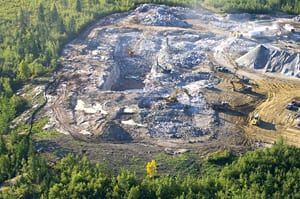Physicists may see data as soon as late summer from the prototype for a $278 million science experiment in northern Minnesota that is being designed to find clues to some fundamental mysteries of the universe, including dark matter.
But it could take years before the nation’s largest “neutrino” detector answers the profound questions that matter to scientists.
Construction is underway now on a 220-ton detector that is the “integration prototype” for a much larger 14,000-ton detector. Both are part of NOvA, a cooperative project of the Department of Energy’s Fermi National Accelerator Laboratory near Chicago and the University of Minnesota‘s school of physics and astronomy. The project may ultimately aid understanding of matter and dark matter, how the universe formed and evolved, and current astrophysical events.
 |
| A 65-foot by 370-foot hole in the ground outlines the future NOvA detector in Minnesota. Photo: Fermilab |
DOE gave “full construction start” approval Oct. 29, 2009 as part of the American Recovery and Reinvestment Act. There are 180 scientists and engineers from 28 institutions around the world collaborating on NOvA.
About 40 scientists from the international collaboration will meet Jan. 8-10 at Southern Methodist University in Dallas. The meeting is the first for the collaboration since DOE’s approval, said John Cooper, NOvA project manager at Fermilab.
Collaboration scientists will hear technical presentations from one another during the three-day SMU meeting, which will refine NOvA’s design, including the technical details of software, hardware and calibration, said Thomas Coan, associate professor in SMU’s Department of Physics and a scientist on the collaboration team.
The integration prototype, known as the Near Detector because it’s at Fermilab, and the larger detector, known as the Far Detector because it’s farther from Fermilab — are essentially hundreds of thousands of plastic tubes enclosing a massive amount of highly purified mineral oil. The purpose is to detect the highly significant fundamental subatomic particle called the “neutrino” and better understand its nature. NOvA, when construction is completed, will be the largest neutrino experiment in the United States.
 |
| NOvA detectors showing planes of alternating vertical and horizontal PVC modules. Photo: Fermilab |
“The ‘detector prototype’ has two purposes,” said Cooper. “First it serves as an ‘integration prototype’ forcing us to find all the problems on a real device, and second it will become the ‘Near Detector’ at Fermilab.”
The integration prototype will operate on the surface at Fermilab for about a year starting in late summer 2010, Cooper said. Then in 2012 it will move 300 feet underground to become the Near Detector, he said. Construction on the Far Detector project began in June near Ash River, Minn. The detector should be fully operational by September 2013, according to Fermilab.
A hard-to-observe fundamental particle that travels alone, the neutrino has little or no mass, so rarely interacts with other particles.
Neutrinos are ubiquitous throughout our universe. They were produced during the Big Bang, and many of those are still around. New ones are constantly being created too, through natural occurrences like solar fusion in the sun’s core, or radioactive elements decaying in the Earth’s mantle, as well as when the particle accelerator at Fermilab purposely smashes protons into carbon foils.
Our sun produces so many that hundreds of billions are zinging through our bodies every second at the speed of light, Coan said. It’s hoped the new detector can resolve questions surrounding the three different kinds of neutrinos — electron, tau and muon — and their “oscillation” from one type to another as they travel, he said.
Scientists at the new detectors will analyze data from Fermilab’s neutrino beam to observe evidence of neutrinos when the speedy, lightweight particles occasionally smash into the carbon nuclei in the scintillating oil of the detector, causing a burst of light flashes, Coan said.
NOvA is looking for the most elusive oscillation of the muon type of neutrino to the electron type, Cooper said. — Margaret Allen
Related links:
Star Tribune: Stimulus funding a shot in the dark
Symmetry Magazine: NOvA construction a boon for Minnesota
NOvA for nonscientists
NOvA
Fermi National Accelerator Laboratory
Thomas Coan
SMU Department of Physics
SMU Dedman College
University of Minnesota
 Physicists may see data as soon as late summer from the prototype for a $278 million science experiment in northern Minnesota that is being designed to find clues to some fundamental mysteries of the universe, including dark matter.
Physicists may see data as soon as late summer from the prototype for a $278 million science experiment in northern Minnesota that is being designed to find clues to some fundamental mysteries of the universe, including dark matter.